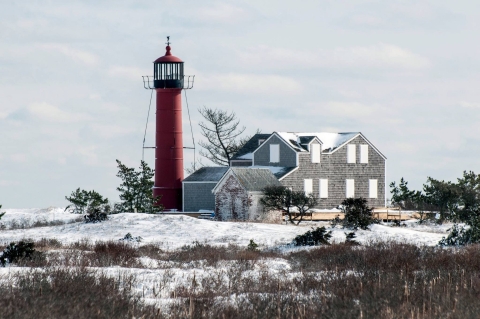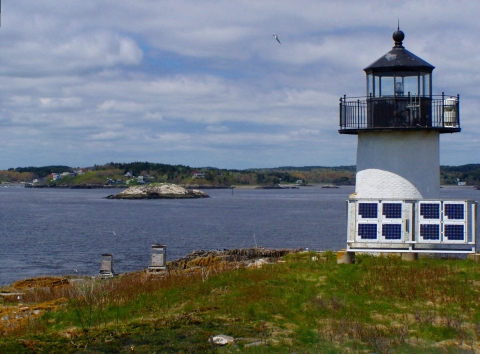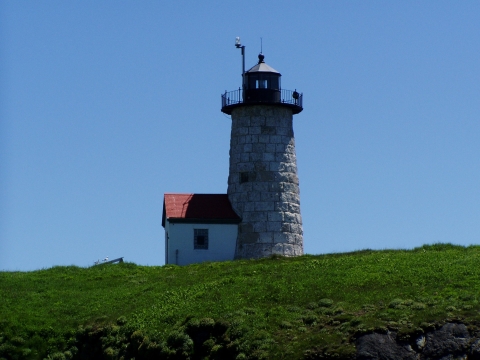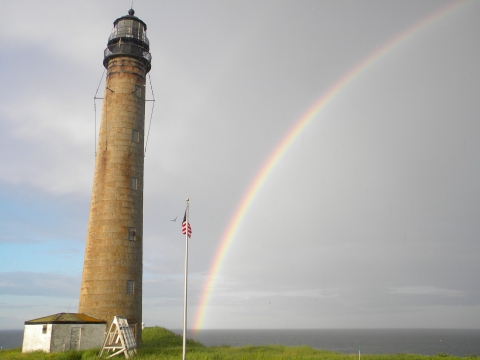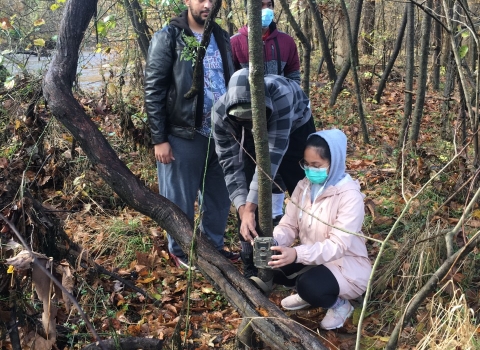When I was a kid traveling on vacation with my family, my mom would have my younger brother and me pose together in front of the few lighthouses we passed along the way for an obligatory photo op.
It is one of the most notable memories of my vacations, visiting the lighthouses, the towering structures, spiraling staircases to the top, the expansive view, the design and color originality.
Lighthouses connect us to an earlier time when they once guided ships safely home.
There are many lighthouses on national wildlife refuges. Eleven in the northeast region alone! Here are 11 interesting facts about U.S. Fish and Wildlife Service lighthouses:
1) Egg Rock Lighthouse at Maine Coastal Islands National Wildlife Refuge recently won honorary mention of the 2016 Historic Preservation Award for recent restoration work on their buildings as well as lighthouses! Egg Rock Lighthouse is an area specifically for protected birds. What a fitting name!
2) Monomoy Point Lighthouse at Monomoy National Wildlife Refuge in Massachusetts was one of the first lighthouses in the nation to be built from cast iron. The land it sits on is constantly shifting, intermittently changing from a peninsula off of Chatham into two islands: Northern and Southern Monomoy. Since a storm in April 2017, the land is currently separated, but in time it may be part of the mainland again.
3) Falkner Island Lighthouse at Stewart B. McKinney National Wildlife Refuge in Connecticut, built in 1802, was termed the ‘Eiffel Tower of Long Island Sound.’ During the early 1800’s the keeper installed a bowling alley and a bar, until a law was enacted prohibiting the sale of liquor on lighthouse property.
4) Assateague Lighthouse at Chincoteague National Wildlife Refuge in Virginia resembles a 142-foot candy cane. It is listed in the National Register of Historic Places and has a light that can be seen 19 miles out at sea.
5) Pond Island lighthouse at Pond Island National Wildlife Refuge, part of Maine Coastal Islands National Wildlife Refuge Complex, is the smallest lighthouse on a national wildlife refuge national wildlife refuge
A national wildlife refuge is typically a contiguous area of land and water managed by the U.S. Fish and Wildlife Service for the conservation and, where appropriate, restoration of fish, wildlife and plant resources and their habitats for the benefit of present and future generations of Americans.
Learn more about national wildlife refuge in the region, standing a mere 20 feet. Despite its name, there isn’t a fresh body of water located anywhere on the rocky island!
6)Thacher Island lighthouse at Parker River National Wildlife Refuge in Massachusetts are America’s only identical twin lighthouses. The north tower, owned by the U.S Fish and Wildlife Service, has 156 steps winding to the top with a view overlooking Rockport Harbor. The south tower is owned by the Town of Rockport. The twin lights were one of the first lighthouses to be used to warn sailors of a “high risk area,” of rocks or shallow water, rather than solely as a harbor entrance light.
7) Finns Point Rear Range Lighthouse at Supawna Meadows National Wildlife Refuge in New Jersey helped settlers continue upriver, passing between Reedy Island and Baker Shoal in search of fertile land on the east bank of the Delaware River.
8) Matinicus Rock Lighthouse at Maine Coastal Islands National Wildlife Refuge was run by a lighthouse keeper’s teenage daughter, Abbie Burgess, in 1856 after her father was not able to return home from a trip to the mainland. She oversaw the lighthouse independently for 21 days keeping the lighthouse running during a treacherous storm.
9) Libby Island Lighthouse at Maine Coastal Islands National Wildlife Refuge is situated near the area of where one of the first naval battles of the American Revolutionary War, the Battle of Machias, took place in 1775.
10) Two Bush lighthouse at Maine Coastal Islands National Wildlife Refuge is named after two trees that once stood as distinguishable landmarks to mariners.
11) Petit Manan Lighthouse at Maine Coastal Islands National Wildlife Refuge was authorized for construction by President James Monroe in 1817 to serve as a guide for ships towards several bays and harbors in the vicinity and also to warn mariners of a dangerous bar between the island and Petit Manan Point on the mainland. A visit to this lighthouse would also give you the chance to see Atlantic puffins! ‘Manan’ is a micmac word meaning ‘island.’
I encourage you to visit these historic landmarks, and the national wildlife refuges where they’re located. Don’t forget to take a silly picture or two…
Egg Rock Lighthouse: Maine Coastal Islands NWR; Winter Harbor, ME. Accessibility: the lighthouse is not open to the public and is best observed by boat.
Monomoy Point Lighthouse: Monomoy NWR; Chatham, MA. Accessibility: Pre-scheduled tours.
Falker Island Lighthouse: Stewart B. McKinney NWR; New Haven, CT. Accessibility: the lighthouse is not open to the public.
Assateague Lighthouse: Chincoteague NWR, Assateague Island, VA. Accessibility: the lighthouse is open on weekends in April through November from 9am to 3pm.
Pond Island Lighthouse: Maine Coastal Islands NWR; Phippsburg, ME. Accessibility: the lighthouse is not open to the public and is best observed by boat.
Thacher Island Lighthouse: Parker River NWR; Rockport, MA. Accessibility: the lighthouse is closed to the public currently.
Finn’s Point Rear Range Lighthouse: Supawna Meadows National Wildlife Refuge; Pennsville, NJ. Accessibility: Pre-scheduled open house tours.
Matinicus Rock Lighthouse: Maine Coastal Islands NWR; Matinicus Isle, ME. Accessibility: the lighthouse is not open to the public and is best observed by boat.
Libby Islands Lighthouse: Maine Coastal Islands NWR; Machiasport, ME. Accessibility: the lighthouse is not open to the public and is best observed by boat.
Two Bush Island Lighthouse: Maine Coastal Islands NWR; Spruce Head, ME. Accessibility: the lighthouse is not open to the public and is best observed by boat.
Petit Manan Lighthouse: Maine Coastal Islands NWR; Steuben, ME. Accessibility: the lighthouse is not open to the public and is best observed by boat.


